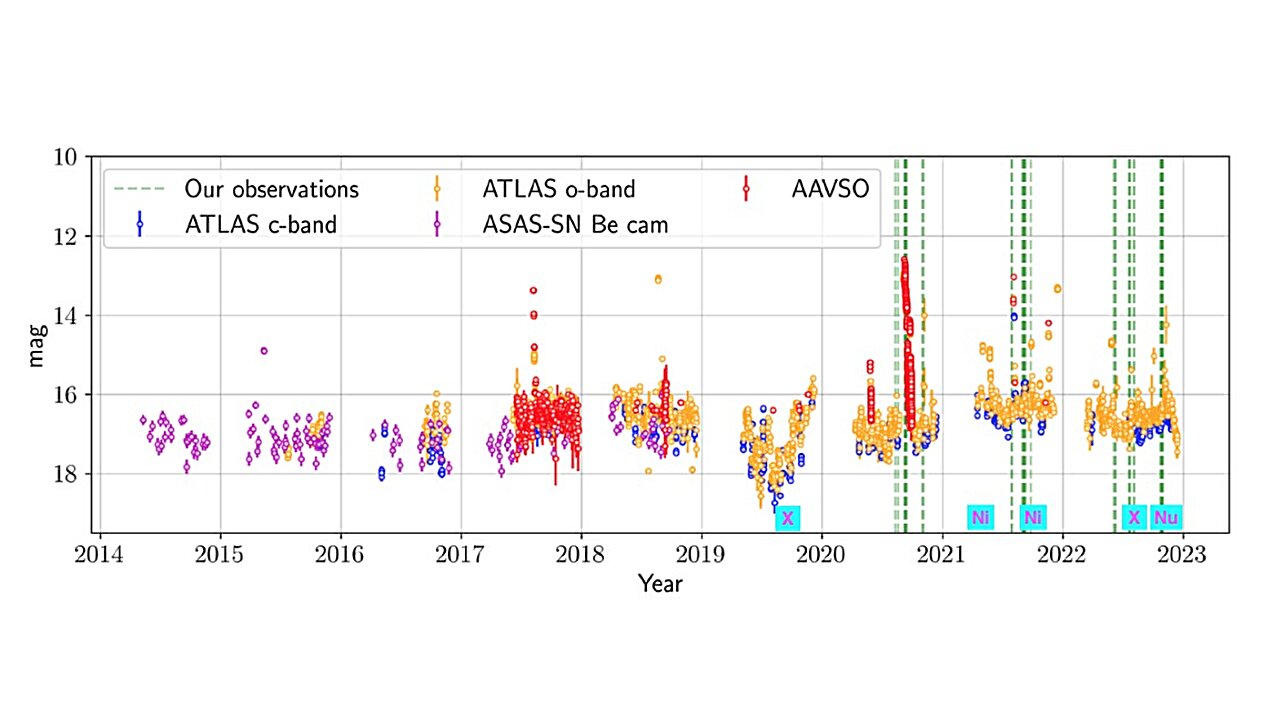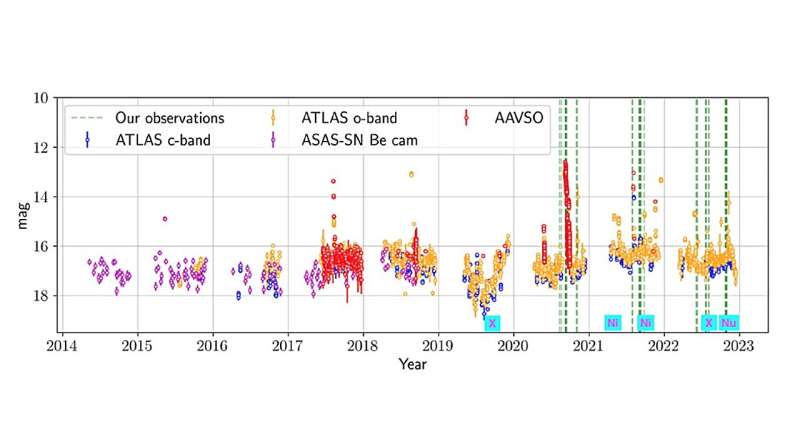

Using various X-ray space observatories, astronomers from Columbia University in New York and elsewhere have investigated CTCV J2056–3014—an intermediate polar containing one of the fastest-spinning white dwarfs. Results of the study, published September 26 on the pre-print server arXiv, shed more light on the nature of this object.
Cataclysmic variables (CVs) are binary star systems consisting of a white dwarf accreting material from a normal star companion. They irregularly increase in brightness by a large factor, then drop back down to a quiescent state. Polars are a subclass of cataclysmic variables distinguished from other CVs by the presence of a very strong magnetic field in their white dwarfs.
In some CVs, accretion occurs through a truncated accretion disk when the white dwarf is moderately magnetic. These systems are known as intermediate polars (IPs). Observations have shown that in IPs, the magnetic white dwarf spins asynchronously with the orbital period of the system and therefore produces a rapid oscillation with the spin period. Therefore, determining a precise spin period and precise oscillation ephemeris could be the key to revealing the IP nature of some CVs.
Located some 853 light years away, CTCV J2056–3014 is a nearby IP detected in 2010. Its white dwarf has a spin period of 29.6 seconds, which makes the system one of the only few known fast-spinning CVs (FSCVs). The orbital period of CTCV J2056–3014 was measured to be approximately 1.76 hours.
Previous observations of CTCV J2056–3014 have found that the system is faint in the X-ray band and also exhibits dwarf novae (DNe) as well as superoutbursts in the optical band, therefore properties indicative of WZ Sge-type CVs. In general, WZ Sge-type CVs exhibit occasional outbursts, indicating more variable mass accretion, including dwarf novae outbursts and the much rarer superoutbursts.
In order to get more insights into the true nature of CTCV J2056–3014, a team of astronomers led by Columbia University’s Ciro Salcedo, decided to employ ESA’s XMM-Newton satellite, NASA’s Nuclear Spectroscopic Telescope Array (NuSTAR) spacecraft, and the Neutron star Interior Composition Explorer (NICER) onboard the International Space Station (ISS), to perform thorough X-ray and optical observations of this system.
Salcedo’s team observed CTCV J2056–3014 between 2019 and 2022. It was found that the pulsed profile of this system is characterized by a single broad peak with about 25 percent modulation. Moreover, a four-fold increase in unabsorbed X-ray flux was detected, coincident with an optical flare that occurred in November 2022.
According to the paper, the properties of CTCV J2056–3014, like low plasma temperatures, and no significant X-ray absorption at low energies, are generally similar to other known FSCVs.
However, the researchers noted that the accretion-powered emission in CTCV J2056–3014 and evidence of an accretion column, combined with the system’s non-magnetic CV properties and weak line of iron identified in its “low” state make its classification uncertain. Therefore, the team plans to publish another research paper in which the optical properties of CTCV J2056–3014 will also be discussed, which could help determine the true classification of this CV.
The authors of the study added that based on the collected X-ray spectral data, they were able to estimate the mass of the white dwarf in CTCV J2056–3014, which was found to be 0.7–1.0 solar masses. This is a typical value for the population of known CV systems.
More information:
Ciro Salcedo et al, A Broadband X-ray Investigation of Fast-Spinning Intermediate Polar CTCV J2056-3014, arXiv (2024). DOI: 10.48550/arxiv.2409.18247
Journal information:
arXiv
© 2024 Science X Network
Citation:
Astronomers investigate the nature of a fast-spinning intermediate polar (2024, October 7)
retrieved 7 October 2024
from https://phys.org/news/2024-10-astronomers-nature-fast-intermediate-polar.html
This document is subject to copyright. Apart from any fair dealing for the purpose of private study or research, no
part may be reproduced without the written permission. The content is provided for information purposes only.